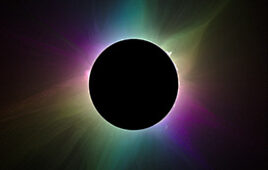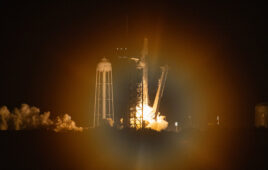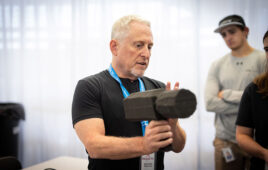Imagine
yourself in orbit, your spacecraft flying backward with its small
window facing down toward the surface of the moon. You peer out,
scouring the ash-colored contours of the cratered landscape for traces
of ancient volcanic activity. Around you, the silent, velvety blackness
of space stretches out in every direction.
The
spacecraft rolls over, and you glimpse a sliver of intense light
starting to climb over the rough horizon. It might be dawn, except that
the bright sliver quickly morphs into an arc of dazzling white swirled
with vivid blue and then rises far enough to be recognized as the
brilliant, marbled Earth. Captured on film, this breathtaking view
becomes the iconic photograph “Earthrise.”
On
December 24, 1968, three people saw this happen firsthand: Apollo 8
Commander Frank Borman and crew members William A. Anders and James A.
Lovell, Jr. Now, in honor of Earth Day 2012, the rest of us can see what
that was like in a new NASA visualization, which draws on richly
detailed maps of the moon’s surface made from data gathered by NASA’s
Lunar Reconnaissance Orbiter (LRO).
“This
visualization recreates for everyone the wondrous experience of seeing
Earth from that privileged viewpoint,” says LRO Project Scientist Rich
Vondrak of NASA’s Goddard Space Flight Center in Greenbelt, Md.
At
the time of the famous photo, Apollo 8 was rounding the moon for the
fourth time, traveling in a nearly circular orbit about 110 km (68
miles) above the moon’s surface at about a mile per second. “The
spacecraft was pointed down to look at the moon’s surface, because
Anders was conducting an extensive photographic survey,” explains James
Rice, an astrogeologist at Goddard. “But Lovell needed to perform a
navigation sighting, so Borman rolled the spacecraft.” That’s when Earth
abruptly appeared.
|
To
recreate this scene, NASA animator Ernie Wright reconstructed the orbit
in software, using coordinates from an Apollo 8 mission report and
photographs taken by the crew. “Apollo 8 was at 11 degrees south
latitude and between 118 and 114 east longitude, with a westward view,”
says Wright. “The floor of Pasteur crater is visible in the foreground
of the photograph.”
Wright
rendered the crisp contours of the moonscape using high-resolution
topography data from LRO’s Lunar Orbiter Laser Altimeter, which has
provided the most precise and complete maps to date of the moon’s
complex, heavily cratered terrain.
The
Earth shown in the visualization is not an exact duplication of what
the astronauts saw but a mosaic of more recent images taken by the
Moderate Resolution Imaging Spectroradiometer (known as MODIS)
instrument on the Terra satellite and assembled by NASA’s Visible Earth
team.
The
narration in the visualization comes from the original audio recording
of the Apollo 8 astronauts, their commentary on the task at hand
interrupted as they react to the sudden sighting of Earth. “Oh my God!”
an astronaut calls out. “Look at that picture over there!”
A
black-and-white image is snapped with one of the Hasselblad cameras on
board, capturing the very first picture of Earth taken by a human in
orbit around the moon. The crew then scrambles to get a color picture,
which is taken 58 seconds after the black-and-white photo.
The
color image, which simultaneously captures Earth’s bold vitality and
its fragility, is later named “Earthrise” and has been reproduced
countless times, including a U.S. postage stamp issued on May 5, 1969.
This popularity earned the photo the featured spot on the cover of
Life’s book “100 Photographs that Changed the World,” in which
wilderness photographer Galen Rowell deemed it “the most influential
environmental photograph ever taken.”
LRO
and LOLA were built and are managed by NASA Goddard. The research was
funded by NASA’s Science Mission Directorate in Washington, D.C. The
visualizations were created at Goddard’s Scientific Visualization
Studio.
LRO and the Lunar Orbiter Laser Altimeter
Source: NASA






